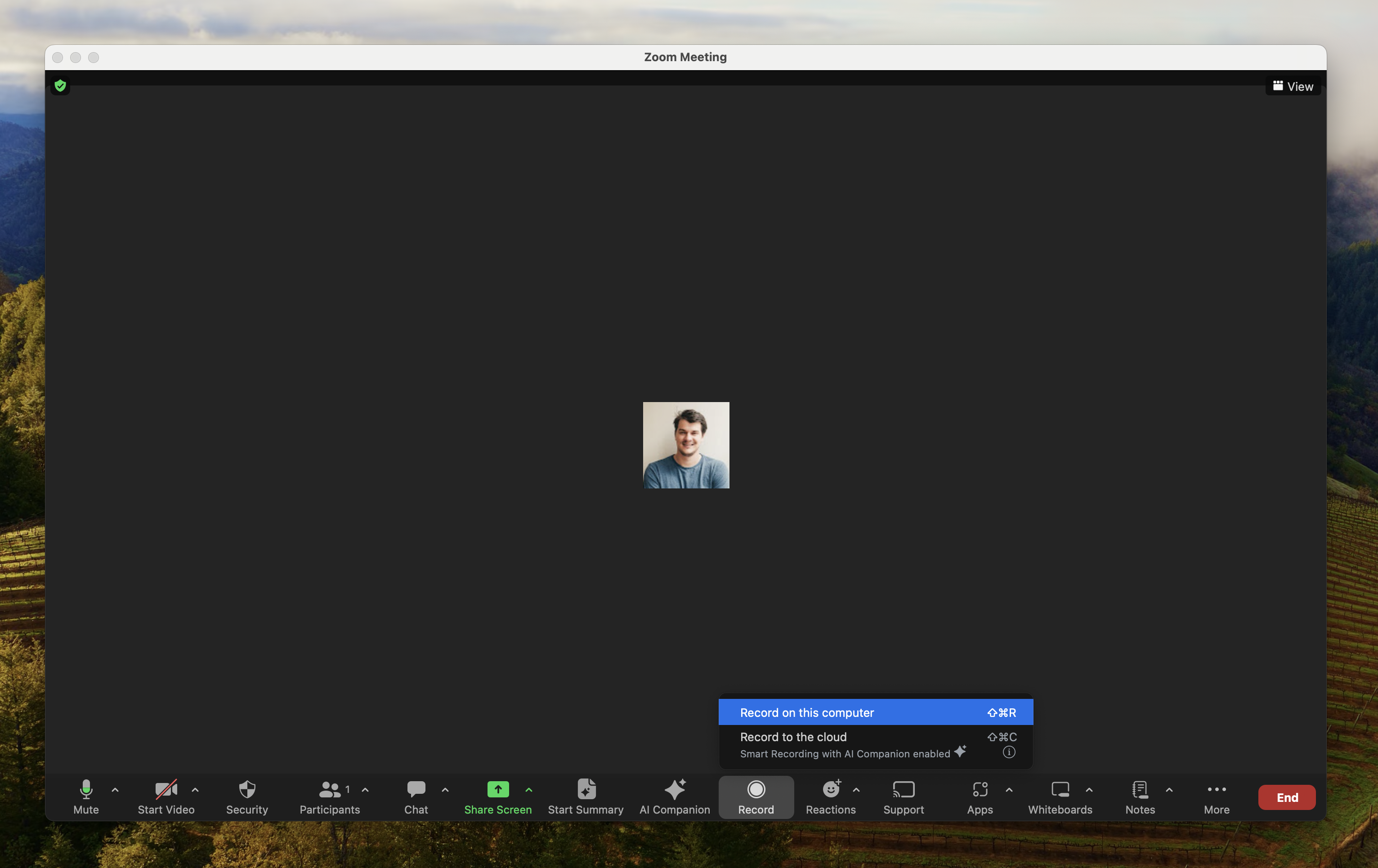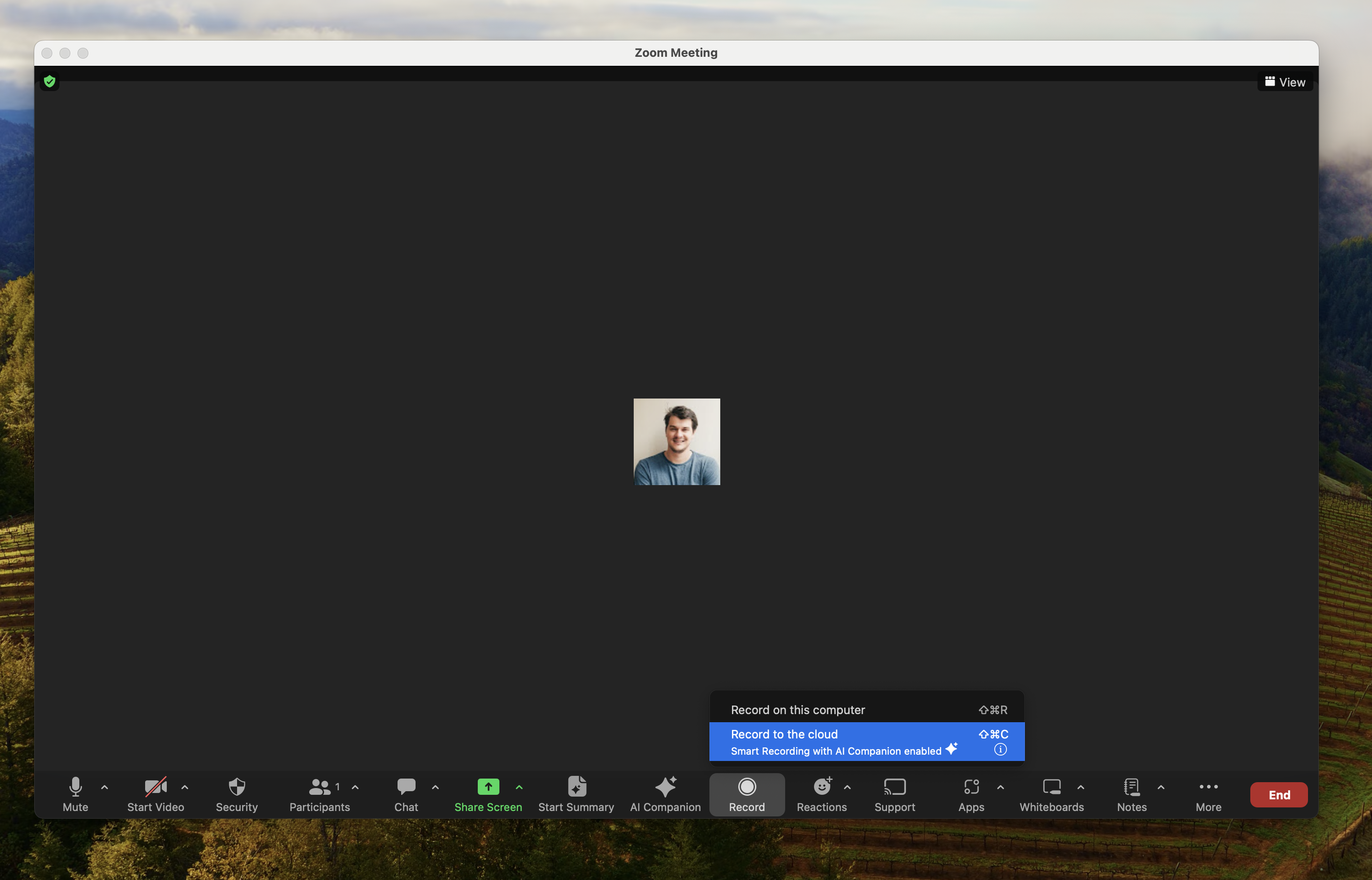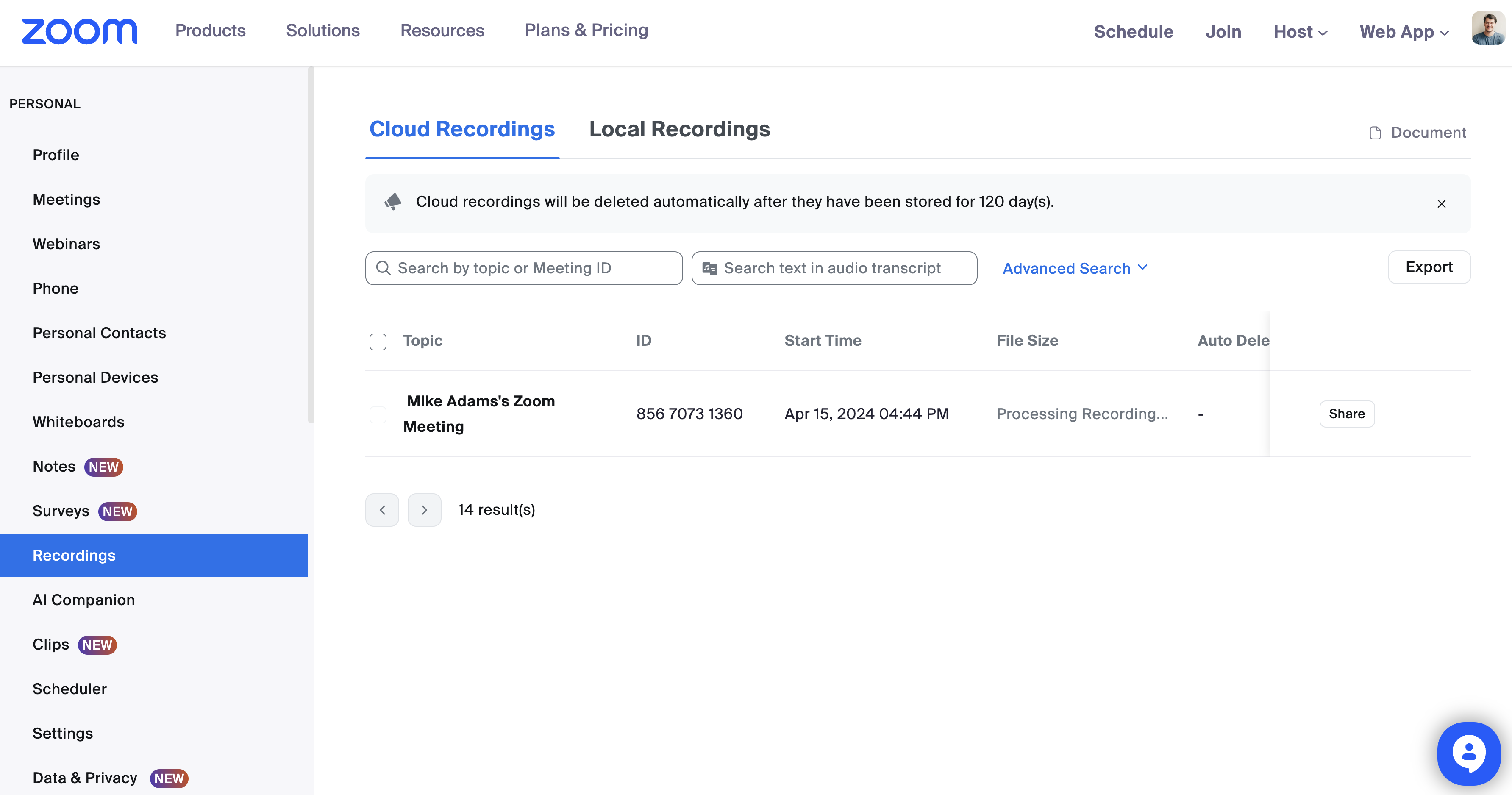The Ultimate 2024 Zoom Record Guide
Need to record a Zoom meeting? You’re in the right place. This article demystifies Zoom recording, whether it’s on the cloud or your local machine, and introduces how Grain can amplify your Zoom record capabilities. Discover succinct steps to ensuring your meetings are captured just as you need them – every time.
Key Takeaways
- Zoom meetings can be captured with high precision, allowing users to seamlessly record, transcribe, and integrate meeting data with other tools for efficient information management and collaboration.
- Zoom offers native recording options, both locally and in the cloud, with advanced features like saving chat messages, adding timestamps, and transcribing audio, designed for easy access and sharing across various platforms.
- Grain enhances the recording process by integrating with Zoom to provide automated recording, AI note-taking, and a searchable library, allowing for the creation and sharing of meeting highlights for effective communication and knowledge retention.
Introduction
Imagine never missing a beat in your meetings, where every discussion point, decision, and clever idea is preserved for posterity. That’s the reality we’re living in, and it’s all thanks to the ability to record our Zoom meetings with precision and ease. At Grain, we’ve transformed meeting captures into an art form over the past six years, harnessing them to extract customer insights, sync notes to our CRM, and review meetings with a sense of security that only comes from knowing nothing is lost.
In this age of AI and Large Language models, the conversational data from your meeting recordings is akin to gold. But to unlock this wealth of information, you must first capture the data. Let’s embark on this journey together to ensure you’re fully equipped to record and leverage information from your Zoom recordings to its fullest potential.
How does recording zoom fit into your use case?
Zoom meetings are the new boardrooms, classrooms, and coffee shops where ideas take flight and deals are sealed. But have you taken a moment to consider what recording method best suits your needs for recorded zoom meetings? Whether it’s a sales pitch, a customer success story, or an intense product research session, the way you plan to use the recorded content is crucial in determining the best method for capturing your meetings.
The majority of our users at Grain, for example, leverage Zoom recordings for customer-facing calls. Aligning your Zoom usage with the right recording approach ensures that you’re capturing the right meetings at the right time and sharing their contents efficiently. Let’s dive into the essential features that will match your recording needs with the perfect method.
Important zoom recording functionality to consider
The functionality of your Zoom recordings should be as versatile as the meetings themselves. Key questions arise:
- Do you require the capability to auto-record meetings?
- Is it necessary to distinguish between internal and external sessions?
- Perhaps you’re even looking to record meetings on other platforms, like Google Meet or Microsoft Teams, when you’re not the Zoom host.
Consider these functionalities carefully, as they can significantly streamline your workflow. For instance, if you’re frequently meeting with clients outside your organization, ensuring that your recordings can:
- Capture external meetings automatically
- Provide transcription services
- Integrate with other productivity tools
- Allow for easy sharing and collaboration
Best three options to record zoom meetings
Zoom conveniently offers two native methods for recording: saving locally to your computer or to Zoom’s cloud storage. But what if you’re not the meeting host and need permission to record a Zoom meeting, or you want to manage recordings for a large team? Zoom’s functionality is excellent, but for those looking for more powerful functionality, third-party solutions like Grain may be a better option.
Grain transcends Zoom’s limitations by:
- Enabling recording across all major meeting platforms
- Providing a centralized space for collaboration
- Automating the busy work of documentation and CRM updates with AI note-taking.
This means even when you’re not the host, you can still easily record and store your meetings.
Option #1: Zoom Local Recording
Zoom's local recording feature allows you to record a meeting directly to your local hard drive. Here's how to use it:
To start a local recording in Zoom, click the "Record" button on the bottom toolbar during your meeting. This will begin recording and saving the video file locally on your computer. The Record button will turn red to indicate that recording is in progress.

By default, Zoom will save recordings to a folder called Zoom on your computer. You can access your local recordings by going to the Zoom client and clicking "Meetings" > "Recorded" to see a list of all your locally saved recordings.

The main benefits of local Zoom recording are:
- Recordings are saved directly on your device so you don't need internet to access them.
- There are no storage limits like there are with cloud recording.
- You have full control over the video files to edit or share as needed.
However, there are some downsides to be aware of:
Local recordings are limited to 12 hours for the free Zoom plan and 24 hours for paid plans
- Storage space on your computer may limit how many recordings you can save locally.
- Sharing and managing local recordings can be more difficult without cloud storage.
Option #2: Zoom Cloud Recording
Zoom offers built-in cloud recording capabilities to easily record and access your meetings from any device. Here's how it works:
To start a cloud recording in Zoom, click the "Record" button on the bottom toolbar during your meeting. Choose "Record to the Cloud". You'll then see a notification that the meeting is being recorded to Zoom's cloud storage.

The main benefits of Zoom cloud recording are:
- Unlimited recording duration - cloud recordings are not restricted by a 40 minute limit
- Limited cloud storage - recordings are uploaded to Zoom's servers so you don't use local disk space
- Easy access - recordings can be accessed from any device by logging into your Zoom account
Potential downsides include:
- Paid Plans Only - Unless you're on a Zoom paid plan, you cannot record to the cloud
- Processing time - recordings may take a few hours to process before they are viewable
- Limited editing features - you cannot easily trim or edit cloud recordings
- Meeting Retention - Depending on which Zoom plan you're on, meetings will be automatically deleted after 180 days or more
Overall, cloud recording makes accessing and sharing meeting recordings seamless without local storage constraints.
Accessing and Sharing Your Zoom Recordings
It may take a few hours after the meeting ends for cloud recordings to fully process and appear in your account. To access and share cloud recordings simply follow these steps:
- Sign into the Zoom web portal.
- Filter through the ‘Recordings’ tab to find what you’re looking for.
- As soon as your cloud recording is ready, you’ll get a notification.
- The recording will be waiting for you under the ‘Recordings’ section in your Zoom profile.

Option #3: Grain 3rd party meeting recorder and AI note-taker
Enter Grain, a tool that revolutionizes the way we think about recording Zoom meetings. By integrating Grain with your Zoom account, you can automate recording and transcription, turning every meeting into a searchable, shareable event. The power of Grain doesn’t stop at Zoom; it extends to other platforms like Google Meet, offering a comprehensive solution for all your meeting needs.

Grain’s AI note-taking capability offers the following benefits:
- Automatic AI Notes - Automatically captures key points and next steps during a meeting, allowing you to focus on engaging with participants
- Auto-record rules - With Grain you can set up rules to automatically record some or all of your Zoom meetings. This saves you the effort of starting recordings manually.
- Record when not host - Grain allows you to record Zoom meetings even when you are not the host. This gives more flexibility compared to Zoom's built-in recording which requires host permissions.
- Searchable transcripts - Grain provides live transcriptions of your Zoom meetings. The transcripts are searchable, shareable, and editable.
- Unlimited storage - Recordings and transcripts are stored securely in your Grain account. There are no storage limits like with Zoom's free plan.
Overall, Grain makes it simple to capture Zoom meetings, access transcripts, share clips, and collaborate. The automatic recording and unlimited transcriptions and storage provide a powerful solution for working with recorded Zoom meeting content.
Comparing the Options
Recording Zoom meetings provides many benefits, from creating meeting transcripts to sharing recordings with colleagues. When deciding the best recording option, consider your specific needs.
If you only need to record occasionally and don't require advanced features, Zoom's free local recording up to 45 minutes may suffice. However, the recordings are harder to manage and share.
For automated and unlimited cloud recordings, Zoom's paid plans allow storing recordings online. But the recordings can be cumbersome to work with compared to more advanced solutions.
Using a platform like Grain provides the most robust recording and transcription capabilities. You get unlimited storage, transcripts, AI-generated notes, easy sharing, and powerful collaboration features.
Grain integrates directly with Zoom to auto-record all your meetings based on rules you set. The recordings and transcripts are securely stored in the cloud and simple to manage.
Recommendation: Record Zoom Meetings with Grain
Grain provides the most flexibility and features for recording your Zoom meetings. Here are some key reasons to choose Grain over the Zoom meeting recording that's built-in options:
- Auto-record all your meetings: Grain can automatically record all your Zoom meetings based on rules you set up. This ensures you never miss capturing an important discussion.
- Take notes and annotate: Grain's AI generates notes during your meetings. You can also highlight and annotate the transcript during or after the meeting.
- Share and collaborate: The Grain library makes it easy to share recordings, transcripts, and notes with your team. You can give feedback, leave comments, and edit clips together.
- Unlimited storage: Grain provides unlimited storage for your recordings, unlike Zoom's limited cloud storage. You'll never run out of space.
- Create highlight reels: With Grain you can easily edit meeting recordings into highlight reels to share key takeaways.
- Integrate with CRM and calendar: Grain connects with tools like Salesforce, HubSpot, and Google Calendar to sync your meeting data.
- Searchable transcripts: Grain's transcripts are fully searchable, making it easy to find key moments and information later.
With its advanced collaboration features, unlimited storage, and AI-powered notes, Grain is the best solution for recording and leveraging your Zoom meetings.
Summary
In sum, the journey to mastering Zoom recording is one of empowerment, enabling you to capture, manage, and leverage the wealth of information that flows through your meetings. With the added capabilities of Grain, you’re equipped with a modern toolkit that not only simplifies the recording process but also enriches the value of your meeting content.
Frequently Asked Questions
Can I record a Zoom meeting on my mobile device even if I'm not the host?
Yes, you can record a Zoom meeting on your mobile device as long as you have the host's permission. Simply tap 'More' during the meeting and select 'Record' to begin capturing the meeting.
How do I access my local Zoom recordings on my computer?
You can access your local Zoom recordings on your computer by navigating to the Zoom folder within your Documents directory, which is located at C:\Users\User Name\Documents\Zoom on Windows and /Users/User Name/Documents/Zoom on Mac.
What are the advantages of using Grain for recording and transcribing Zoom meetings?
Using Grain for recording and transcribing Zoom meetings provides enhanced recording features like auto-record rules, AI note-taking, and the ability to create and share highlights, which are not available with Zoom's native recording options.
How can I set up auto-recording for my Zoom meetings with Grain?
To set up auto-recording with Grain, create an account, and establish auto-record rules in your account settings to customize the recording settings based on the meeting type. This will ensure that your Zoom meetings are automatically recorded as per your preferences.
Can I edit the start and end times of highlights I create with Grain?
Yes, you can edit the start and end times of highlights created with Grain, allowing you to share only the most relevant content from your recordings.



.png)



